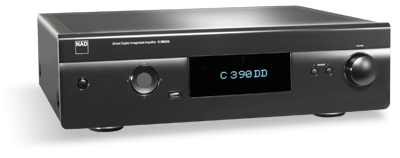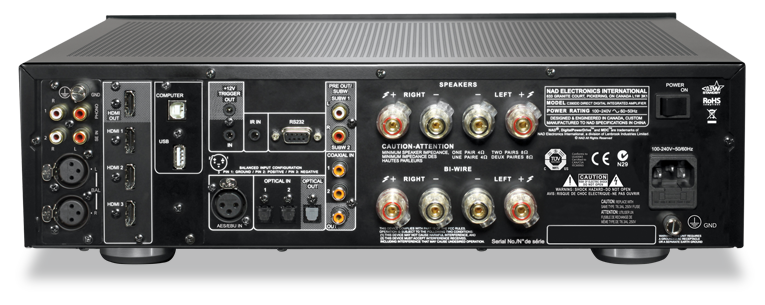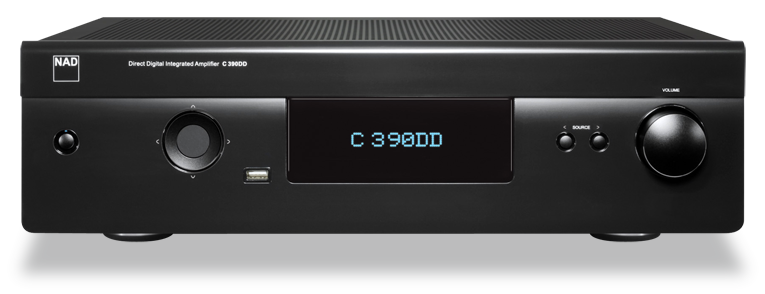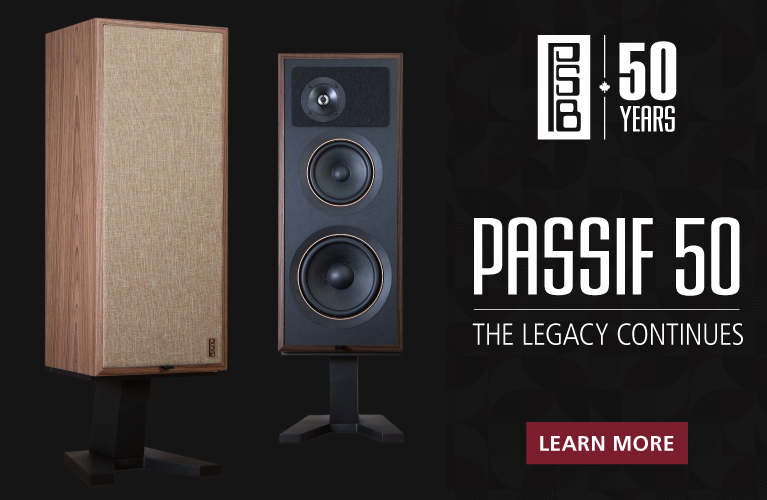
 Buyers of relatively inexpensive audio gear often benefit from technology trickled down from higher-priced models, and a prime example is NAD’s C 390DD Direct Digital integrated amplifier ($2599 USD), a product of development work done for the company’s stunning flagship amplifier, the Masters Series M2 ($5999). The heavily computerized C 390DD is, if you’ll excuse the pun, a chip off the old block.
Buyers of relatively inexpensive audio gear often benefit from technology trickled down from higher-priced models, and a prime example is NAD’s C 390DD Direct Digital integrated amplifier ($2599 USD), a product of development work done for the company’s stunning flagship amplifier, the Masters Series M2 ($5999). The heavily computerized C 390DD is, if you’ll excuse the pun, a chip off the old block.
What sets the M2 -- and now the C 390DD -- apart from other amplifiers is their lack of analog circuitry. Like other amps, NAD’s Direct Digital models accept analog signals -- the sort output by your disc player, DAC, or phono preamp -- but don’t just pass them through, amplifying the signal along the way. Instead, they convert the analog signal into a 24-bit/192kHz digital one, process it in the digital domain with some seriously sophisticated circuitry, then reconvert it to an analog signal that is then sent to the speakers. Despite the multiple conversions that old-school thought might argue should ruin the music, the final analog signal sounds remarkable.
The C 390DD costs less than half the price of the M2. Yes, the M2 has a much more robust power supply and higher-grade parts, but its little brother brings with it some new features that the M2 lacks, such as room-equalization software, and a modular design that allows the owner to expand the C 390DD’s capabilities and turn it into a quite flexible home-entertainment device. The review sample came equipped with two optional modules installed: the DD HDM-1 HDMI module, and the DD AP-1 analog input and phono module. Each module costs a reasonable $299, making the C 390DD’s total price $3197, as tested.
The C 390DD’s modularity extends to its rear-panel USB input. Currently, the amplifier’s standard 35-bit/108MHz master clock USB DAC accepts signals of resolutions up to 24/96. That’s not state-of-the-art, but it allows the NAD to handle the vast majority of music signals out there, including most high-resolution downloads. It’s likely that, before long, a higher-spec USB DAC will be offered as an upgrade. Nor do you need to connect the C 390DD to a computer to take advantage of its three USB inputs. One on the rear panel will accept a FAT32 external hard drive, while the port on the front panel will play music from thumb drives or memory sticks.

NAD’s specifications for the 17-pound C 390DD include a power output of 150Wpc into 8 ohms, but as many know, NAD’s power ratings are as conservative as BMW’s performance specs. Where some amp makers provide only peak power-output specs, the C 390DD is claimed to deliver 150Wpc of continuous power; in other words, it will play very loud all day long without distorting or breaking a sweat. NAD accomplishes this feat with their Digital PowerDrive circuitry, which adjusts the amplifier’s output to match the electrical characteristics of the loudspeakers; and their Soft Clipping circuitry, which prevents the signal from clipping and making horrible noises that would otherwise have you running for the volume control.
Two nice features of the C 390DD are a remote control that looks as if it belongs to an amplifier costing $2600, and, around back, two sets of binding posts for each speaker, to enable biwiring. The remote covers every function of the C 390DD and a lot more -- it’s the same all-purpose model that accompanies NAD’s A/V receivers. Despite all the unused buttons, I never found myself hunting for functions, or pushing the wrong button and getting no results. The remote’s glossy black finish is classy, and a major leap forward from NAD remotes of old.
Setup
Setting up the C 390DD was typically easy but left me with a choice to make. Should I feed the C 390DD the analog output of my Ayre Acoustics QB-9 D/A converter, only to have the NAD immediately reconvert it to digital? Or should I connect my iMac’s Furutech USB cable directly to the C 390DD’s USB input? I elected to minimize conversions and wired the iMac to the C 390DD, removing the Ayre from the equation. I took advantage of the NAD’s HDMI inputs by running my Apple TV and Xbox through them, and connected the amp’s outputs to my reference Definitive Technology Mythos ST speakers with Synergistic Research Galileo cables and speaker cells. For part of my listening I also used Aperion’s Verus Grand Bookshelf speakers, in order to test the C 390DD’s bass control -- the Mythos STs’ woofers have their own amplifiers.
Listening
Over the years, I’ve reviewed a number of integrated amplifiers in place of my reference Simaudio Moon i5.3 integrated, and some have impressed me a great deal. Each time I swapped out the Sim for a review amp, I could always hear a clear sonic character. That wasn’t the case with the NAD C 390DD, which, after 100 hours of break-in, in some ways did a remarkable impression of not being there at all.
If I had to use only one word to describe my first impression of the C 390DD, it would be power. Actually, make that POWER. The C 390DD muscled its way into my heart as has no other amp I’ve reviewed. I’m not just talking about its ability to play loud -- with 150W of continuous power, the C 390DD could play very loud indeed -- but rather about the muscle apparent even at lower volumes, when the music contained hefty bass and deep impacts. When that muscle is lacking, a pipe organ doesn’t sound as it should, double basses don’t resonate into a deep abyss, and kick drums sound more like nudge drums. With the C 390DD, music suffered no such deficiency of muscle, even when the NAD was driving small bookshelf speakers like the Aperion Verus Grands. That speaker may have only a 5” midrange-woofer and a small cabinet, but the C 390DD got out of the little Aperions everything they had to give, without speakers or amp ever sounding as if they were anywhere near their limits -- whether it was the pounding bottom end of Green Day’s American Idiot (24/96 FLAC, Reprise), or the simpler but powerful bass lines of Ron Carter’s version of “All Blues” on 4 Generations of Miles (24/96 FLAC, Chesky/HDtracks).
With both of my sets of speakers, the C 390DD had me marveling at the stunning clarity of its reproduction across the audioband. That deep bass impact was accompanied by equal measures of detail and air, of the textures of bass-guitar strings and the sizes of recording spaces, the sound of felt-tipped hammers on piano strings. Listening to music through the NAD was a lot like seeing HDTV for the first time: a marvelous hearing of the familiar world through a pristine pair of new ears. I’ve written before about hearing “into” music, but, oh man, not like this.

Take that seminal audiophile recording Jazz at the Pawnshop (24/88.2 FLAC, Proprius). Drummer Egil Johansen’s playful swirling and slapping of brushes in “Limehouse Blues” has long been a favorite of mine, but never before had I heard so much of what those brushes were up to. It’s one thing to hear the familiar shhhhh and swish; it was another to think I could tell how many bristles were in contact with the drum skin. It’s one thing to hear the internal resonance of a snare drum when struck by a stick, but to hear the swishing bouncing around inside the snare -- well, that’s the kind of resolution that sends shivers down an audiophile’s spine. And I could hear really deeply into Diana Krall’s voice in the title track of Glad Rag Doll (24/96 FLAC, Verve). The C 390DD’s magic was apparent even with tracks of standard “Red Book” resolution: k.d. lang’s warbling (or is it yodeling?) in “I Confess,” from Sing It Loud (16/44.1 AIFF, Nonesuch), sounded like the highest-resolution recording ever made, for all I could tell. No matter what I listened to, I could listen for hours on end. Listener fatigue? Only from the clock telling me it was way past bedtime.
One of the reasons plain old 16/44.1 sounded terrific on the C 390DD was that this was one superquiet amp. When I cranked up the volume with no signal present, I heard nothing -- nothing in the background, no white noise competing with the music I was trying to hear. That makes a huge difference in perceived sound quality, and when an amp is as quiet and superbly musical as the C 390DD was, it’s something special indeed. NAD says that the C 390DD’s distortion and noise are nearly unmeasurable, but even that is probably typical NAD understatement. I’ll bet the white coats at Los Alamos National Laboratory could measure the distortion and noise, but I doubt there are any human ears on this planet that can hear it.
Comparison
I usually write a review in sequence, from the introduction through the Setup, Listening, Comparison, and Conclusions sections. It’s funny that I forgot about the Comparison until the end, but it’s entirely fitting -- the NAD C 390DD made me forget all about my Simaudio Moon i5.3 ($3000 when available). Don’t get me wrong -- the Simaudio is an excellent, clean, and musical integrated amplifier, but I never once missed it in the few months I had the C 390DD in my system. Everything the i5.3 does well -- dynamics, detail, midrange realism, tight bass -- the C 390DD did better. What the Moon i5.3 can’t do in the same league as the C 390DD -- and, in fairness, the i5.3 has only half the NAD’s power output -- is grab hold of a woofer and show it who’s boss. In that department, the Moon i5.3 is a handgun, the C 390DD was a howitzer. And, as I said, the NAD was supremely quiet. I’d never thought the Moon i5.3 was anything less than that, but there’s black, and then there’s center-of-a-singularity black.
I did eventually pipe my Ayre QB-9 DAC into the C 390DD’s analog input, to hear how it compared with what the NAD’s USB DAC could do on its own. The problem, of course, was that the NAD wasn’t only amplifying the Ayre’s D/A conversion, it was converting it back into digital, upsampling it to 24/192, then reconverting it to analog and sending it on to the speakers. That said, there was a very noticeable difference in the sound when the Ayre was in circuit. I actually preferred the “native” sound of the NAD over the Ayre-NAD combo; the latter sounded a little veiled, a little subdued in the mids, and the resolution was a little lower. I’m not sure what to conclude from this, as the NAD’s architecture precludes calling this a comparison of the NAD and Ayre. The best takeaway would be that if you don’t already have a USB DAC, you won’t need one if you buy an NAD C 390DD. If, like me, you do have a USB DAC, you might need to find it a new owner.
Conclusions
What, precisely, is the NAD C 390DD? I keep referring to it as an integrated amplifier, but it belongs in a class of its own -- or, at least, in a class taught by its big brother, the Masters Series M2 Direct Digital. The C 390DD isn’t an integrated amplifier with a built-in DAC; it’s much more sophisticated than that. It’s likely the most sophisticated amplifier available at its price. In this ever-changing world, sophistication and modularity are good things, and the C 390DD offers both. That it’s also a superb music-reproduction device and sounds invisible is a major achievement, and, at its price, a phenomenal one.
. . . Colin Smith
colins@soundstagenetwork.com
Associated Equipment
- Speakers -- Definitive Technology Mythos ST, Aperion Verus Grand Bookshelf
- Integrated amplifier -- Simaudio Moon i5.3
- DAC -- Ayre Acoustics QB-9
- Computer -- Apple iMac running Decibel
- Cables -- Furutech GT2 USB, Analysis Plus Blue Oval interconnect, Synergistic Research Galileo speaker cable
- Power cords -- Synergistic Research T2 (amp) and T3 (DAC)
- Power conditioner -- Blue Circle Audio BC6000
NAD C 390DD Direct Digital Integrated Amplifier
Price: $2599 USD.
Warranty: Two years parts and labor.
NAD Electronics International
633 Granite Court
Pickering, Ontario L1W 3K1
Canada
Phone: (905) 831–6555
Fax: (905) 837-6357
Website: www.nadelectronics.com






















